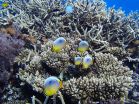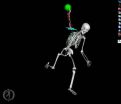(Press-News.org) A new scientific synthesis suggests a gradual, prolonged release of greenhouse gases from permafrost soils in Arctic and sub-Arctic regions, which may afford society more time to adapt to environmental changes, say scientists in an April 9 paper published in Nature.
"Twenty years ago there was very little research about the possible rate of permafrost carbon release," said co-author A. David McGuire, U.S. Geological Survey senior scientist and climate modeling expert with the Institute of Arctic Biology at the University of Alaska Fairbanks. "In 2011, we assembled an international team of scientists into the Permafrost Carbon Network to synthesize existing research and answer the questions of how much permafrost carbon is out there, how vulnerable to decomposition it is once it's thawed, and what are the forms in which it's released into the atmosphere."
Permafrost soils contain twice as much carbon as there is currently in the atmosphere. As the climate warms and permafrost thaws, microbial breakdown of organic carbon increases and can accelerate the release of carbon dioxide and methane into the atmosphere creating even more warming. In high-latitude regions of the Earth, temperatures have risen 0.6 C per decade during the last thirty years - twice as fast as the global average.
Permafrost has warmed nearly 11 degrees F in the past 30 years, according to co-author Vladimir Romanovsky, a permafrost expert with the UAF Geophysical Institute. In the 1980s, the temperature of permafrost in Alaska, Russia and other Arctic regions averaged to be almost 18 F. Now the average is just over 28 F.
Two decades ago, scientists thought that as permafrost thawed, carbon would be released in a big "bomb" and significantly accelerate climate warming.
"The data from our team's syntheses don't support the permafrost carbon bomb view," said McGuire. "What our syntheses do show is that permafrost carbon is likely to be released in a gradual and prolonged manner, and that the rate of release through 2100 is likely to be of the same order as the current rate of tropical deforestation in terms of its effects on the carbon cycle."
Most climate modelers want to incorporate the permafrost carbon feedback into their models, say these scientists, but whether they do or don't is a matter of their priorities given the multitude of issues that such models must consider. McGuire, Romanovsky and their co-authors consider the synthesis very important information for climate models in setting their priorities.
"If society's goal is to try to keep the rise in global temperatures under two degrees C and we haven't taken permafrost carbon release into account in terms of mitigation efforts, then we might underestimate that amount of mitigation effort required to reach that goal," McGuire said.
Scientists in the Permafrost Carbon Network plan to continue to help the modeling community make refinement to improve representation of permafrost carbon and its fate in a warming world. They recommend improved observation networks, including remote sensing capabilities to quantify real-time carbon dioxide and methane emissions from permafrost regions.
INFORMATION:
A. David McGuire, U.S. Geological Survey, Alaska Cooperative Fish and Wildlife Unit senior scientist; University of Alaska Fairbanks, Institute of Arctic Biology, professor of ecology, admcguire@alaska.edu, 907-474-6242
Vladimir Romanovsky, University of Alaska Fairbanks, Geophysical Institute, professor of geophysics, veromanovsky@alaska.edu.
Marie Thoms, University of Alaska Fairbanks, Institute of Arctic Biology, communications and web manager, methoms@alaska.edu, office: 907-474-7412, mobile: 907-460-1841, @ArcticBiology, iab.uaf.edu
Diana Campbell, University of Alaska Fairbanks, Geophysical Institute, public relations assistant, dlcampbell@alaska.edu, office: 907-474-5229.
Fish are the key ingredients in a new recipe to diagnose and restore degraded coral reef ecosystems, according to scientists from the Australian Institute of Marine Science, WCS, James Cook University, and other organizations in a new study in the journal Nature.
For overfished coral reef systems, restoring fish populations that perform key roles will in turn restore ecological functions critical to recovery. For moderately or lightly fished reefs, the recipe requires knowing which fish to catch, how many, and which to leave behind.
The authors assessed fish biomass ...
EVANSTON, Ill. --- A new approach to analyzing baseball-pitching biomechanics may one day give players more personalized feedback and help prevent elbow injuries.
In a computer simulation study of baseball pitching, Northwestern University biomedical engineers found that the strength of the elbow muscles of a baseball pitcher likely play a bigger role in injury risk and prevention than previously thought.
The motion analysis approach currently used in the baseball industry to provide athletes with injury-risk feedback is not sophisticated enough to estimate what an ...
April 8, 2015--Researchers at Columbia University's Mailman School of Public Health and Columbia Business School studied bed capacity --measured by the number of staffed beds -- in New York City hospital obstetrics units and found a significant excess number of beds, which overall cost the city an estimated $26.4 million each year. The findings, coupled with the current trends of an aging population and the declining birth rate, suggest that many obstetrics units could reduce their bed capacity and still assure timely access to care. Study findings are published in the ...
CAMBRIDGE, Mass--Biologists at MIT and the Whitehead Institute for Biomedical Research have discovered a vulnerability of brain cancer cells that could be exploited to develop more-effective drugs against brain tumors.
The study, led by researchers from the Whitehead Institute and MIT's Koch Institute for Integrative Cancer Research, found that a subset of glioblastoma tumor cells is dependent on a particular enzyme that breaks down the amino acid glycine. Without this enzyme, toxic metabolic byproducts build up inside the tumor cells, and they die.
Blocking this enzyme ...
BOSTON (April 8, 2015) -- A two-year epidemiological study of Puerto Rican adults with type 2 diabetes in the greater Boston area who were using insulin and lived next to roads with heavy traffic had markedly increased C-reactive protein, a marker of inflammation, compared to those living in lower traffic areas. Individuals taking oral diabetes medications did not experience increases in CRP concentration. The study, published online in Environmental Pollution, builds on the research team's previous work suggesting that oral diabetes medications may provide a protective ...
Since 2007, California has had one of the most aggressive incentive programs in the country for putting solar-electric panels on the rooftops of homes and businesses. Its $2.2 billion California Solar Initiative (CSI)has provided a per-watt rebate for installing residential and commercial photovoltaic systems. During this period, the solar industry in the state has experienced double-digit growth and to date has installed more than 245,000 systems capable of producing 2,365 megawatts of electricity.
As a result, CSI has been widely touted as a major success. However, ...
Numerous studies over the past 30 years have linked exposure to nature with improved human health and well-being. These findings are of growing importance: In the near future, 70% of the world's population will live in cities, where they will face a rising tide of lifestyle-related disease. Still, little is known about the mechanisms underlying the nature-health connection, and confusion awaits those who would transform existing findings into action.
In the June issue of BioScience, a group of biologists and public health experts led by Danielle F. Shanahan address this ...
The ceremonial opening kick of the 2014 FIFA World Cup in Sao Paolo, Brazil, which was performed--with the help of a brain-controlled exo-skeleton--by a local teen who had been paralyzed from the waste down due to a spinal cord injury, was a seminal moment for the area of neuroscience that strives to connect the brain with functional prosthetics. The public display was a representative of thousands of such neuroprosthetic advances in recent years, and the tens of years of brain research and technological development that have gone into them. And while this display was quite ...
Strong vertical wind shear has taken a toll on Tropical Cyclone Ikola and that was pretty clear in a visible-light image from NASA-NOAA's Suomi NPP satellite today, April 8.
When Suomi NPP flew over Tropical Cyclone Ikola at 07:05 UTC (3:05 a.m. EDT), the Visible Infrared Imaging Radiometer Suite or VIIRS instrument aboard captured a visible image of the storm.
VIIRS is a scanning radiometer that collects visible and infrared imagery and "radiometric" measurements. Basically it means that VIIRS data is used to measure cloud and aerosol properties, ocean color, sea and ...
A University of Calgary study has found that rats fed a fibre supplement while on a high fat and high sugar diet show a much lower weight gain than those who did not eat the fibre. A team of researchers from the university's Cumming School of Medicine and the Faculty of Kinesiology says the study helps scientists better understand the mechanisms of weight control and energy balance.
"Our data shows that a simple dietary intervention, with a prebiotic oligofructose fibre, reduced weight gain, and this may also lead to the long-term maintenance of a lower body weight in ...


